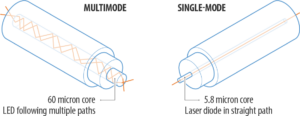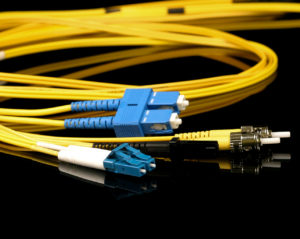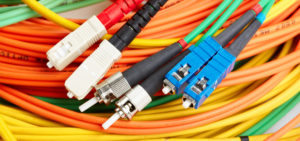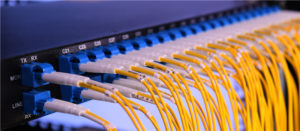There are a number of questions regarding Fiber Optic Cable and its application that can quickly dial down to a preferred product offering.
The Fiber Mode:
Single-mode or Multimode Fiber Optic Cable
Fiber optic cable can be divided into single-mode fiber cable and multimode fiber cable. Single-mode optical fiber generally has a core diameter of 9 µm and requires laser technology for sending and receiving data. It can carry a signal for miles, which makes it ideal for telephone and cable television providers. As the name suggests, multimode fiber permits the signal to travel in multiple modes, or pathways, along the inside of the glass strand or core. It is available with fiber core diameters of 62.5 µm or 50 µm. Although the core sizes of single-mode fiber and multimode fiber differ, both fiber types end up with an outer diameter of about 250 µm.

Multimode
- a)5/125um Multimode. Industry standard multimode cable. There are large amounts of legacy equipment on the market and already installed that this cable supports.
- b)50/125um Multimode. Many newer pieces of equipment can use either 62.5 or 50 micron multimode cable. 50 micron has a larger bandwidth capability.
- c)50/125um Laser Enhanced Multimode. Primarily for 10 Gigabit Ethernet applications. This cable has been optimized for laser applications and can support 10G applications to 300 or 500 meters. Not a bad idea for future proofing either.
Single Mode

Single mode is used for long haul or extreme bandwidth applications.
The Fiber Count:
Fiber counts can be from One Fiber to 144 Fibers. Choices are: 1, 2, 4, 6, 8, 12, 18, 24, 36, 48, 60, 72, 84, 96, 108, 120, 132, 144.
It is recommended to always pull more fiber than needed. You only get to pull once and future content demands will continue to require more bandwidth.
The jacket rating and type
Jacket color is relatively standardized:

- a) Multimode = Orange
- b) 50/125um 10Gig = Aqua
- c) Single Mode = Yellow
- d) Indoor/Outdoor or Outdoor = Black
- e) Custom jacket colors are also available for indoor fiber cables
PVC (OFNR), OFNP, or LSZH
Fiber optic cable jackets can provide strength, integrity and overall protection of the fiber member. PVC is widely used as a cable jacket for many applications—computers, communications, low-voltage wiring, etc. PVC can potentially be dangerous in a fire situation, releasing heavy smoke and hydrogen chloride gas, which can be irritating to humans and corrosive to electronic devices. OFNP, or plenum jackets, are suitable for use in plenum environments such as drop-ceilings or raised floors. Many data centers and server rooms have requirements for plenum-rated cables. LSZH is a jacket made from special compounds which give off very little smoke and no toxic halogenic compounds when burned.

What type of fiber optic cable should i use? When choosing the fiber optic cable, please always remember the elements mentioned in this article. Only make clear all these aspects can you select the fiber optic cable that most suits your applications. If you are still confused about which one to choose, you can search www.tarluz.com, you will get more information.
